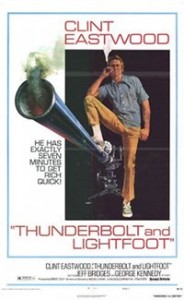 “Thunderbolt and Lightfoot” is a rare treat, where all the stars seemed to align perfectly, making for a great motion picture experience. It took one screen tough guy, combined with an up and coming actor and a future Oscar-winning director. Those elements all elevate what could have been a normal heist film into a true American classic.
“Thunderbolt and Lightfoot” is a rare treat, where all the stars seemed to align perfectly, making for a great motion picture experience. It took one screen tough guy, combined with an up and coming actor and a future Oscar-winning director. Those elements all elevate what could have been a normal heist film into a true American classic.
There is no doubt that Michael Cimino is a talented director and this is him in top form before the roller coaster of his career damaged his reputation as a filmmaker. “Thunderbolt and Lightfoot†[1974] was a humble and promising movie that captured audiences and cast critics attention on his talent. What followed was the 1978 Best Picture winner, “The Deer Hunter.” That movie allowed him to become the next big thing in Hollywood. MGM invested so much faith in the Oscars that they gave him a chance to direct his next opus, “Heaven’s Gate” which ultimately put the major studio into bankruptcy. Luckily, the lion did roar again a year later.
However, soon after, Cimino’s career sank quicker than the Titanic and while he has continued to work over the years, the spotlight never shined on him again.
That however has little to do with the caliber of “Thunderbolt and Lightfoot.â€
The plot is your typical heist picture, but is transcended into something more by the top-notch performances all across the board. An aging bank robber now in hiding meets a happy-go-lucky young sidekick that convinces him to do one more big robbery. He then reunites with his former partners to perform the task.
Clint Eastwood portrays John “Thunderbolt” Doherty in one of the performances of his career. Doherty is a quiet man with a gruff demeanor, who takes a liking to his younger and energetic sidekick. They have what could be best described as a father and son relationship and a deep care for one another. This proves that even tough guys need a good buddy in their journey in life. This element is so important here that one doesn’t even need the heist aspect to the film for it to be a success.
If you ever wondered where the term “star-making performance” came from, then look no further than Jeff Bridges’ Oscar-nominated performance as Lightfoot. This picture was Bridges at the prime of his career, where he matched the veteran Eastwood scene for scene. Here Bridges plays a young and extremely charismatic con-artist. It is impossible not to smile when he’s on screen. Lightfoot is a skirt chasing, prankster with glimpses of a dramatic side from time-to-time and that makes the character more than just a comedic side-kick.
One scene when where he is in drag is hysterical and his performance throughout will leave you with a tear in your eye.
The villain of the piece is portrayed by the former Oscar-winner for Best Supporting Actor [“Cool Hand Luke”] George Kennedy. As part of Thunderbolt’s gang, he is a ruthless piece of garbage that only cares about getting the money. He can’t stand Lightfoot’s carefree outlook on life and often tries to crush the young man’s spirit. Kennedy is a very good actor that is often overlooked because his career got pushed aside in the 80’s. Watch this film and “Cool Hand Luke†however and you will understand what a good actor this man is. Then check out “The Naked Gun” series and try to forget those lousy Breath Assure ads that he did.
Simply put, this is not only Cimino’s legacy, but also Kennedy’s as well, proving just how talented they really were.
Often cited for being a tad verbose, Cimino’s two biggest movies clock in at over three hours. “Thunderbolt and Lightfoot†is just under two hours, showing that he did know how to use an editing room. It flies by in no time.
In the 70’s a renaissance was taking over Hollywood, when performances mattered over material. It’s a period that is hard not to miss due to the actors that reveled and thrived during the time. Watch Eastwood, Bridges, and Kennedy thrive here in a great piece of motion picture art and watch the renaissance unfold right before your very eyes.

Leave a Reply